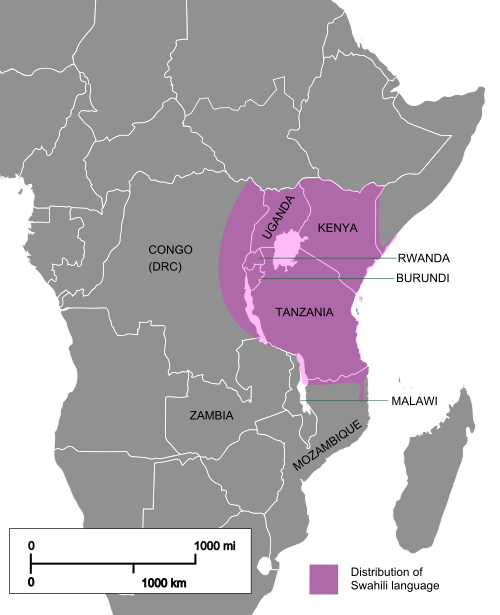IB Syllabus focus:
'Investigate the impact of immigration and emigration on African societies during this period, including the reasons for migration.'
Delving into the transformative effects of migration on Africa, this section explores the multifaceted reasons behind the shifts and their significant implications for the continent’s societies.
Historical Context of Migration in Africa
Pre-Colonial and Colonial Migrations
Indigenous migrations were commonplace, shaped by trade routes, conquests, and the establishment of various kingdoms and empires.
The transatlantic slave trade had already forcefully displaced millions of Africans, setting a precedent for subsequent forced migration patterns.
Colonialism introduced new boundaries, often disregarding ethnic and linguistic groupings, leading to significant internal migrations and alterations in pre-existing migration patterns.
Post-Colonial Migration
Following independence, many African nations experienced significant political upheaval, resulting in new waves of migration both within and beyond the continent.
The quest for improved living conditions and employment continued to drive population movements well into the late 20th century.
Causes of Immigration and Emigration
Economic Factors
Resource Distribution: Uneven distribution of resources led to migration towards mineral-rich areas or fertile lands.
Industrialisation: The growth of industries and urban centres under colonial regimes attracted rural populations.
Social Factors
Cultural Ties and Marriage: Social practices such as inter-tribal marriage promoted migration, as people moved to join spouses.
Escape from Social Stigmas: Individuals sometimes migrated to escape social stigmas or for the freedom to practise customs freely in more cosmopolitan environments.
Political Factors
National Service and Conscription: Some colonial and post-colonial governments enforced military service, prompting avoidance migration.
Ethnic Cleansing and Genocide: Tragic events, like the Rwandan Genocide, caused mass emigration and refugee crises.
Consequences of Migration on African Societies
Demographic Changes
Rural Depopulation: As young adults migrated to urban areas or overseas, some rural areas experienced significant depopulation.
Population Swells in Mining and Urban Areas: Areas around resources like the Kimberley diamond mines in South Africa saw population booms.

A panoramic 1892 engraving of Kimberley shows the open-pit diamond mine and the dense settlement that grew around it, illustrating how extractive hubs drew in migrant labor from across southern Africa. Such centers reshaped local demographics and accelerated urbanization under colonial capitalism. Source
Economic Impact
Informal Economy Growth: The influx of migrants into cities led to the expansion of the informal economy as newcomers sought livelihoods outside formal sectors.
Social and Cultural Dynamics
Language Spread: Migrations led to the spread of languages like Swahili, which became lingua francas in many urban centres.

This linguistic map highlights the core Swahili-speaking region along the East African coast and interior corridors where the language spread with trade, migration, and urbanization. It visualizes how mobility reinforced Swahili’s role as a lingua franca across key towns and routes. Source
Cultural Syncretism: The blending of different cultures led to unique syntheses, as seen in music, cuisine, and religious practices.
Impact on Identity
Hybrid Identities: Migration gave rise to complex identities, with individuals often identifying with both their place of origin and their new communities.
Urbanisation and Social Transformation
Social Strains: Rapid urbanisation due to migration placed pressure on infrastructure and housing, often leading to the development of informal settlements.
Reasons for Migration
Aspirations for a Better Life
Climbing the Social Ladder: The perception of urban centres as places to achieve upward social mobility was a strong pull factor.
Adventure and Exploration: Some individuals were motivated by the desire to experience life beyond their immediate surroundings.
Migration Policies and Legislation
Colonial Restrictions
Forced Labour Systems: Systems such as corvée labour in French colonies required Africans to work on projects like road construction, often far from their homes.
Independence Era Policies
Nationalism and Xenophobia: Emerging national identities sometimes led to xenophobia, influencing immigration policies and attitudes towards migrants.
Diaspora Communities and Transnational Ties
Political Activism
Anti-Apartheid Movement: The South African diaspora was instrumental in the global anti-apartheid movement.
Pan-Africanism: The diaspora also played a crucial role in promoting pan-African ideologies, which had a significant impact on political thought and action on the continent.
Challenges and Controversies
Human Trafficking and Illegal Migration
Mediterranean Crossing: The perilous journey across the Mediterranean became a route for thousands seeking better lives in Europe, often resulting in tragedy.
Refugee Crises
Regional Hosts: Countries like Kenya and Ethiopia hosted large refugee populations, impacting their societies and economies.

An aerial photograph of the Ifo 2 refugee camp within Kenya’s Dadaab complex, established in 1991, shows the scale and spatial organization of a major late-20th-century refugee settlement. Such camps concentrated migrant populations and reshaped local economies and services in host regions. This specific image dates to 2011, reflecting continued expansion after the camp’s 1990s origins. Source
Integration and Multiculturalism
Role of International Organisations
Policy Influence: Organisations such as the African Union (AU) have worked to harmonise migration policies across the continent, promoting orderly and humane management of migration.
Multicultural Urban Societies
Cultural Festivals and Media: The celebration of diverse cultures in urban centres and through media contributed to a sense of unity in diversity.
Effects of Migration on Women and Families
Changing Family Structures
Shift in Household Dynamics: With men frequently migrating for work, women often took on additional domestic responsibilities and economic roles.
Women as Migrants
Education and Employment: The search for education and employment opportunities led to increased female migration, both internal and international.
Impact on Education and Skills Development
Education as a Pull Factor
Access to Education: For many African families, the prospect of better educational opportunities for their children was a major incentive to migrate.
Brain Drain versus Brain Gain
Skill Shortages: The emigration of skilled professionals left some countries with critical skill shortages in sectors such as healthcare and education.
Returnees: Conversely, some migrants returned with new skills and experiences, contributing to development at home.
Conclusion
These patterns of immigration and emigration have been central to shaping the contemporary African landscape, culturally, economically, and politically. By understanding these movements, one gains insight into the evolving nature of African societies and the myriad factors influencing them during the tumultuous 19th and 20th centuries.
FAQ
Migration had a profound impact on the spread of religions in Africa, particularly Islam and Christianity. As Muslim traders and Christian missionaries moved across the continent, they interacted with diverse populations, leading to religious conversions. Migrants took their faiths to new regions, integrating religious practices with local traditions and thereby creating unique syncretic forms of worship. In urban areas, where migrants from different backgrounds settled, religious diversity increased, facilitating a landscape where Islamic and Christian institutions flourished side by side. This migration not only widened the geographical spread of these religions but also contributed to their dynamic and evolving nature in the African context.
During the 19th and 20th centuries, remittances began to play a vital role in the economies of many African countries. As migrants settled in areas with better economic opportunities, they sent money back to their families, which became a crucial source of income for many households and, by extension, local economies. These funds were often used for education, health care, and investment in small businesses, which could contribute to the diversification of rural economies. In some instances, remittances have been so substantial that they formed a significant part of the national Gross Domestic Product (GDP). However, reliance on remittances also made some economies vulnerable to global economic fluctuations, which could affect the financial stability of migrants' families back home.
Migration within and between African countries served as a conduit for the spread of political ideas and ideologies. Migrants carried with them the experiences of colonial rule, resistance, and the aspirations for independence, thereby facilitating a cross-pollination of political thought. For instance, workers who migrated to mines or plantations, where they often faced exploitation, returned to their homelands with heightened political consciousness and a greater resolve for resistance, spreading anti-colonial sentiments. Furthermore, students and intellectuals who traveled abroad for education brought back with them ideas of nationalism, socialism, and democracy, which played significant roles in the independence movements. Thus, migration acted as a catalyst for political mobilisation and the sharing of revolutionary ideas that ultimately shaped the continent's push towards independence.
Immigration and emigration had a significant impact on linguistic diversity across African countries. As people moved, they brought their languages with them, which often led to multilingualism, especially in urban areas and regions with a high concentration of migrants. The need for interethnic communication in these areas fostered the development and adoption of lingua francas, such as Swahili in East Africa and Pidgin languages in West Africa. While this enhanced communication between diverse groups, it also posed a challenge to the survival of some local languages, as younger generations in particular might adopt more dominant or widespread languages over their indigenous ones. The linguistic landscape thus became more complex, with the coexistence and intermingling of a multitude of languages shaping identities and social interactions.
Migration patterns within Africa, especially from rural to urban areas, significantly challenged traditional kinship systems. With the movement of individuals, particularly the younger generation, to urban centres for work, the communal life that relied heavily on extended family networks was disrupted. Traditionally, these networks facilitated the sharing of resources, collective farming, child-rearing, and social ceremonies, fostering a strong sense of community and interdependence. As people migrated, these ties were often weakened, leading to a more nuclear family structure and individualistic culture prevalent in urban settings. In many cases, the elderly and children were left behind in villages, which affected the transmission of cultural practices and led to the gradual erosion of communal life that had previously been a cornerstone of African societies.
Practice Questions
Economic factors were undoubtedly significant in driving migration within Africa, particularly due to the allure of industrialising urban centres and employment opportunities in mining regions. However, the notion of economic motivations being the most significant can be nuanced by the influence of political factors such as ethnic conflicts and post-independence power struggles, which equally prompted mass movements. The impact of economic factors was intertwined with these political dynamics, and while they provided the pull in many instances, often it was the push of political instability that initiated migration flows. An excellent student would recognise the multifaceted causes of migration, understanding that economic factors, while critical, were part of a complex interplay of social, political, and cultural forces shaping migratory patterns.
Migration had profound effects on the social structures of African societies. It led to urbanisation, which in turn caused demographic shifts and transformed traditional social hierarchies. The rural depopulation and urban swelling altered familial roles, often empowering women to take on more significant roles in the economy and household decision-making due to the absence of men. Additionally, migration fostered multiculturalism and hybrid identities in urban centres, contributing to the cultural and linguistic diversity of African societies. However, it also strained traditional social support systems, leading to the growth of informal settlements and challenging existing social networks. An excellent student would identify both the positive and negative impacts of migration on social structures, with specific reference to shifts in gender roles and the formation of new cultural identities.

